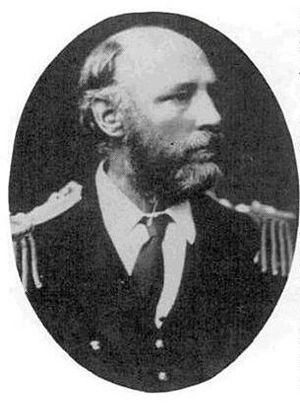James Erskine (Royal Navy officer) facts for kids
Quick facts for kids
Sir James Erskine
|
|
|---|---|

Sir James Erskine
|
|
| Born | 2 December 1838 Rajkot, Bombay Presidency |
| Died | 25 July 1911 (aged 72) Venlaw, Peeblesshire |
| Allegiance | |
| Service/ |
|
| Years of service | 1852–1908 |
| Rank | Admiral of the Fleet |
| Commands held | HMS Speedwell HMS Columbine HMS Eclipse HMS Boadicea HMS Garnet Australia Station Coast of Ireland Station North America and West Indies Station |
| Awards | Knight Commander of the Order of the Bath |
Admiral of the Fleet Sir James Elphinstone Erskine (2 December 1838 – 25 July 1911) was a very important officer in the Royal Navy. He started his career serving in the North America and West Indies Station. This was a tricky time for relations between the United Kingdom and the United States.
Later, Erskine became a private secretary to Lord Northbrook, who was the main leader of the Royal Navy. He then became the senior naval officer in charge of the Australia Station. In this role, he announced that the southern coast of New Guinea would become a British protectorate. This meant Britain would protect and partly control the area to help the local people. He also served as a junior leader in the navy's main office and later as the top commander for the North America and West Indies Station.
Contents

James Erskine was born in 1838. His father was James Erskine, and his mother was Mary Eliza Erskine. He joined the Royal Navy in 1852 when he was just 14 years old. In January 1858, he was assigned to the paddle frigate HMS Valorous. This ship was part of the North America and West Indies Station.
He was promoted to lieutenant in June 1858. A year later, in July 1859, he became a special assistant to his uncle, Rear Admiral John Elphinstone Erskine. His uncle was the second-in-command of the Channel Squadron.
In December 1860, Erskine moved to the ship HMS Aboukir. This ship was also on the North America and West Indies Station. This period was difficult for Britain and the United States. A US Navy ship, USS San Jacinto, stopped a British mail ship, RMS Trent. The US ship took two diplomats who were traveling to Britain and France. This event, called the Trent Affair, caused a big argument between the two countries during the American Civil War. In 1862, Erskine inherited Venlaw, a large house in Scotland.
Rising Through the Ranks
Erskine was promoted to commander in August 1862. He then commanded several ships. In February 1865, he led the gunboat HMS Speedwell off the coast of West Africa. In January 1868, he became the commanding officer of the sloop HMS Columbine in the Pacific Ocean.
He became a captain in November 1868. He commanded the corvette HMS Eclipse in the North America and West Indies Station starting in November 1873. Later, he commanded the corvette HMS Boadicea in Portsmouth in April 1878. After that, he commanded the corvette HMS Garnet off the South East Coast of America in October 1878.
Protecting New Guinea

In May 1880, Erskine became a private secretary to Lord Northbrook, the main leader of the Royal Navy. In January 1882, he became the senior naval officer in charge of the Australia Station. His main ship there was the armoured cruiser HMS Nelson.
While in Australia, he made an important announcement. To help the local people, the southern coast of New Guinea would become a British protectorate. This meant Britain would offer protection and some control over the area. In late 1884, he led an expedition on the Nelson. They traveled to places like Port Moresby and other islands. During this trip, they held ceremonies to officially declare the protectorate and raise the British flag. A reporter and a photographer joined the expedition to document everything.
Senior Command Roles
Erskine was promoted to rear admiral in January 1886. He became a junior leader in the navy's main office in February 1886. However, he left this role six months later when the government changed. In 1888, he became the Senior Officer for the Coast of Ireland Station. His main ship there was the battleship HMS Triumph.
In February 1892, he was promoted to vice admiral. That same year, he made big changes to his home, Venlaw. He added an extra floor and a large new section with a tower.
In May 1895, Erskine became the top commander for the North America and West Indies Station. His main ship was the cruiser HMS Crescent. He was honored as a Knight Commander of the Order of the Bath in June 1897. In August 1897, he was promoted to full admiral. In August 1898, he joined a group that dealt with fishing disputes around the French Islands of Saint Pierre and Miquelon.
On April 20, 1901, Erskine was appointed as a special naval aide to the King. He reached the highest rank in the navy, Admiral of the Fleet, on October 3, 1902. He retired in December 1908. Sir James Elphinstone Erskine passed away at his home, Venlaw, in Peeblesshire, on July 25, 1911, at the age of 72.
Family Life
In 1885, James Erskine married Margaret Eliza Constable. She was the daughter of Reverend John Constable. They had one son and one daughter together.

